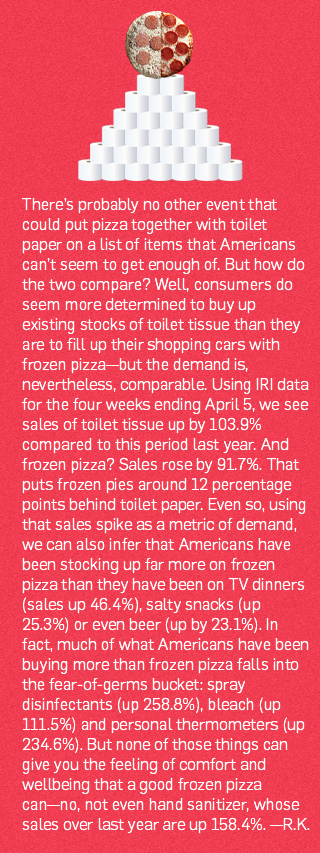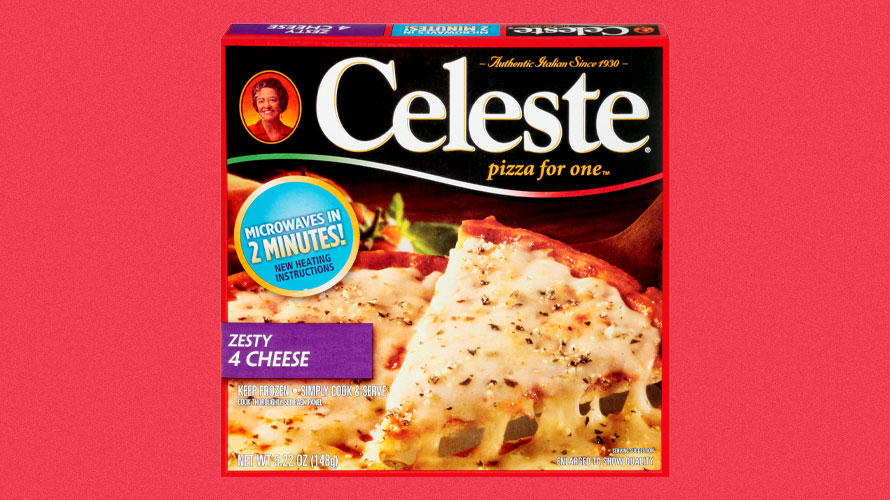That said, economists have so far failed to establish a causal statistical relationship between sales of frozen pizza and sales of toilet paper. Stay tuned. JL
Robert Klara reports in Ad Week:
Frozen pizza sales are up by triple digits. Pizza is attractive because it's cheap but also because, in a time of crisis, it's a comfort food. Americans filled their shopping carts with $275 million worth of the stuff for the four weeks ending April 5. That’s a 92% increase from the same period a year ago. Since 41% of American households include children under 18, pizza is the crowd-pleasing food that’s least likely to get the dreaded veto.
Key insights:
- Frozen pizza sales are up by triple digits.
- Pizza is attractive because it’s cheap but also because, in a time of crisis, it’s a comfort food.
- The shortage of frozen pies might be further economic proof of the fabled "Pizza Principle."
If you were to take a spin down Argonne Drive in Woodridge, Ill., just south of the I-55 interchange, you’d pass the plant belonging to Home Run Inn Pizza. And if you were to take that drive one night this week, you might notice something unusual about the place. While most every business in this suburb 30 miles southwest of Chicago has been shut down by the coronavirus, Home Run Inn’s pizza plant is in overdrive, its lights burning well past sundown.The 60,000-square-foot factory (which not only runs two high-speed pizza lines but does all its own cheese, meat and sauce production as well) has been cranking seven days a week, 16 hours a day since the middle of March. Normally, the place operates two hours a day less than that and powers down completely on weekends. And while the plant turned out about 55,000 pizzas daily during normal times, the owners have dialed the output up to 85,000.And, vp of branding Gina Bolger says, it’s still not enough to meet the demand.“It’s incredible,” Bolger said. “We equate this to every day being like Super Bowl Sunday—the orders don’t stop. The demand is through the roof. We’re trying to keep up as best we can.”The experiences of Home Run Inn, a 73-year-old Chicagoland favorite that also ships its frozen pies nationally, are by no means unique. From coast to coast, demand for frozen pizza has reached heights not seen in generations.“I’ve been in this business over 25 years, [and] I’ve never seen a spike like this across the country,” said Newman’s Own president and COO Dave Best, who reported that sales of his company’s frozen pizzas are up by 190% since the coronavirus crisis began. “This is unprecedented,” he added.Where did all the dough go?
While media coverage of panic buying and hoarding has tended to focus on items like bottled water and toilet paper (and how hand sanitizer somehow became more precious than a good beluga caviar) the bare racks left by shoppers who’ve filled their fridges at home with frozen pizzas have drawn considerably less attention.Even so, a simple box of frozen pizza has become something of a rare bird nowadays. As of the middle of March, for instance, grocery stores across Los Angeles could barely keep the stuff in stock. In the Massachusetts town of Fall River two weeks ago, one truck driver for Schwan’s, maker of the Red Baron brand, resorted to padlocking his trailer for fear that panicked shoppers would break in. Last week, Minnesotans called off the friendly competition among the state’s frozen pizza brands to allow them to focus on simply feeding people. “There are no rivalries right now,” Heggies Pizza owner Shawn Dockter told the Star Tribune.How much frozen pizza are people buying? According to data analytics firm IRI, Americans filled their shopping carts with $275 million worth of the stuff for the four weeks ending April 5. That’s a 92% increase from the same period a year ago.It’s not only pizza that’s scarce, of course. Nervous Americans facing weeks or even months of sheltering at home have been busy buying up plenty of shelf-stable foods—among them boxes of mac and cheese, pasta and spaghetti sauce, and pancake mix. But manufacturers say there are attributes unique to frozen pizza that make it particularly desirable in trying times like these.Why do we love thee, pizza? Let us count the ways
The most obvious thing frozen pizza has going for it is cost. Take the $3.98 that Walmart wants for a 20.6-ounce Red Baron pepperoni pizza. Assuming that two slices makes a meal, that means two people can have dinner for $1.99 a head. And with the Department of Labor’s calculated unemployment rate of 5.1% for the week ending March 28 and some 16 million Americans having lost their jobs in the past three weeks alone, cutting household expenses is now the order of the day.(A spokesperson for Schwan’s Consumer Brands told Adweek it had no time for an interview, citing “our leaders’ focus on ensuring the safety of our people and operations and, of course, our customer deliveries.”)Another reason you can’t find frozen pizza in stores is widespread home confinement and the fact that meals eaten out are now almost entirely being prepared and consumed at home. Best said he first noticed his sales start to climb around the week ending March 8. “That’s when consumers in the U.S. started to eat out less,” he said. But things really took off starting March 22, by which time millions of Americans had begun working from home.“That increases home consumption dramatically,” Best said. “There’s been a big shift from people eating out to people eating in.”Finally, since an estimated 41% of American households include children under 18, pizza is the crowd-pleasing food that’s least likely to get the dreaded veto from the finicky ones. “It’s comfort food,” Bolger said. “It’s perfect for kids to make. It’s a great snack. You pop it in the oven—it’s convenient.”“It’s not hard to imagine that many people are looking for easy, convenient solutions that are also crowd-pleasing family favorites,” seconded Ashley Lind, director of demand sciences at Celeste pizza parent Conagra Brands, whose frozen pizza business has grown by over 100% from this time a year ago. “Also,” Lind added, “when living in uncertain times—as many of us are right now—we’re seeing a rise in consumers turning to much-loved comfort foods. Frozen pizza checks a lot of these boxes for consumers.”With demand comes problems
But while the demand has been good, if slightly frantic news for manufacturers right now, many are also facing the sort of strains that limit supply which, combined with the insatiable demand, also helps explain all those empty freezer cases.For Home Run Inn, the biggest hurdle is finding enough labor to keep its plant going. “We’ve been up front with our employees and making sure everyone feels comfortable and safe,” Bolger said, “but that is the challenge.”Home Run Inn has also been shipping its pizza out through its direct-store delivery program, by which its own workers enter supermarkets and stock the freezer cases. The more traditional distribution method of sending pizzas to the grocery chains’ own warehouses is beset by bottlenecks, Bolger said.As for Newman’s Own, Best is pleased that the manufacturer for his brand already had two suppliers lined up for every ingredient well before COVID-19 came to town and, for now, he sees no major interruptions in the near term.Still, he added, “our supply chain is stretched, [and] their supply chains are stretched.”Further proof of the “Pizza Principle”?
It’s worth mentioning how the dearth of frozen pizza also evokes a longstanding (and unaccountably accurate) practice of using pizza and other convenience foods as a gauge for the economy overall.If the price of a slice goes up, it’s a fair indicator of the concomitant rise in commodity prices for cheese, wheat and tomatoes. In New York, the fabled “Pizza Principle” has established an uncanny correlation between the cost of a slice and the price of a ride on the subway and, by association, the overall cost of living in the Big Apple.In fact, theorists have stumbled across quite a few correlations between junk food and various economic indicators. By comparing the retail price of a Big Mac in the U.S. with the burger’s corresponding price in a less-developed country, for instance, some enterprising economists have developed a rough measure of that nation’s economic productivity and its standard of living..






















0 comments:
Post a Comment